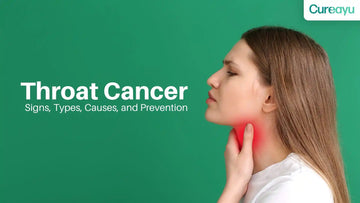Throat cancer, though not as commonly discussed as other cancers, can be a life-threatening condition if not detected early. This form of cancer primarily affects the throat (pharynx), voice box (larynx), or tonsils, and can spread quickly if left untreated. Recognizing the early signs of throat cancer is crucial for timely diagnosis and treatment, which can significantly improve survival rates.
Early detection of throat cancer often hinges on recognizing subtle symptoms that are frequently mistaken for other, less serious health issues. In this blog, we’ll explore what throat cancer is, the different types, common symptoms, causes, and ways to prevent it. By understanding these factors, you can stay informed and aware of potential risks, leading to early intervention if needed.
Also Read: Types Of Cancer: What, Where and How of the Cancer Varieties
What Is Throat Cancer?
Throat cancer refers to malignant tumors that develop in the throat, voice box, or tonsils. It begins when cells in these areas grow out of control, forming a tumor that can invade nearby tissues or spread to other parts of the body. Throat cancer is most commonly associated with the squamous cells that line the throat and voice box, but it can also develop in other types of cells.
This type of cancer can affect different parts of the throat, such as the nasopharynx (upper part of the throat behind the nose), oropharynx (middle part of the throat), and hypopharynx (lower part of the throat). Throat cancer can also extend to the voice box (larynx) and tonsils. Risk factors like smoking, excessive alcohol consumption, and certain infections can increase the likelihood of developing this disease.
Types Of Throat Cancer
-
Nasopharyngeal Cancer
This type of throat cancer affects the nasopharynx, which is located behind the nose and above the back of the throat. It’s rare compared to other types and is more common in certain parts of Asia and Africa. Symptoms often include nasal congestion, nosebleeds, and hearing loss. -
Oropharyngeal Cancer
Oropharyngeal cancer develops in the oropharynx, the middle part of the throat, which includes the tonsils and the back of the tongue. Smoking and human papillomavirus (HPV) infection are significant risk factors. Common symptoms include difficulty swallowing, a lump in the throat, and persistent sore throat. -
Hypopharyngeal Cancer
This cancer forms in the lower part of the throat, the hypopharynx, which connects the throat to the esophagus. It is often diagnosed in advanced stages because early symptoms are subtle. Signs may include pain when swallowing, ear pain, and a lump in the neck. -
Laryngeal Cancer
Laryngeal cancer affects the voice box or larynx. It can affect the vocal cords, leading to hoarseness or voice changes. Smoking and heavy alcohol use are leading causes. Symptoms often include hoarseness, trouble breathing, and coughing up blood. -
Tonsil Cancer
This form of cancer begins in the tonsils, which are part of the oropharynx. Tonsil cancer is increasingly linked to HPV infection. Symptoms can include a sore throat, difficulty swallowing, and a lump in the neck.
Also Read: Cancer – Where it Starts: Understanding Symptoms, Causes, and Early Detection
Signs Of Throat Cancer
-
Persistent Sore Throat
A sore throat that doesn’t go away even after treatment could be an early sign of throat cancer. While sore throats are common, persistent pain lasting more than two weeks should not be ignored. -
Hoarseness or Voice Changes
Changes in your voice, such as hoarseness that lasts for more than two weeks, could indicate cancer in the voice box. This is often one of the earliest signs of laryngeal cancer. -
Difficulty Swallowing (Dysphagia)
Throat cancer can cause difficulty swallowing, often due to a tumor obstructing the passage of food or liquid. Dysphagia may feel like a lump in the throat or chest, leading to pain while eating. -
Ear Pain
Persistent pain in one ear, without any signs of an ear infection, can be a sign of throat cancer. This is particularly common in hypopharyngeal cancer, where the pain can radiate from the throat to the ear. -
Lump in the Neck
A painless lump or swelling in the neck is often a sign that the cancer has spread to the lymph nodes. If you notice a lump that doesn’t go away, it’s important to seek medical advice. -
Unexplained Weight Loss
Sudden, unexplained weight loss is a common sign of many types of cancer, including throat cancer. If you are losing weight without changing your diet or exercise routine, it could be an indication that something is wrong. -
Coughing Up Blood
If you experience frequent coughing and notice blood in your sputum, this could be a sign of advanced throat or laryngeal cancer. It is crucial to see a doctor immediately if this occurs.
Reasons For Throat Cancer
-
Smoking
Cigarette, cigar, and pipe smoking are significant risk factors for throat cancer, particularly laryngeal and hypopharyngeal cancers. The toxins in tobacco can damage the cells lining the throat, leading to cancer. -
Alcohol Consumption
Excessive alcohol intake, especially when combined with smoking, increases the risk of throat cancer. Alcohol irritates the lining of the throat, making it more susceptible to carcinogenic substances. -
Human Papillomavirus (HPV)
HPV infection, particularly HPV-16, is linked to oropharyngeal cancer. HPV-related throat cancers are on the rise, especially among younger, non-smoking individuals. -
Poor Diet
A diet lacking in fruits and vegetables can contribute to throat cancer, as these foods contain antioxidants and vitamins that protect cells from damage. -
Exposure to Asbestos and Other Toxins
Long-term exposure to certain environmental toxins, such as asbestos and industrial chemicals, increases the risk of developing throat cancer, particularly in industries like construction and manufacturing. -
Gastroesophageal Reflux Disease (GERD)
Chronic acid reflux, or GERD, can lead to inflammation and damage to the lining of the throat, increasing the risk of throat cancer over time.
Also Read: Mouth Cancer Symptoms: Understanding Early Signs, Causes, Prevention, and Treatment
Prevention
-
Quit Smoking
The most effective way to reduce your risk of throat cancer is to stop smoking. Seek support through cessation programs or nicotine replacement therapies to quit for good. -
Limit Alcohol Intake
Reduce alcohol consumption to lower your risk. If you drink, do so in moderation, and avoid mixing alcohol with tobacco products. -
Get Vaccinated for HPV
Vaccination against HPV can significantly reduce the risk of oropharyngeal cancers. The HPV vaccine is most effective when administered before exposure to the virus, typically in adolescence. -
Eat a Healthy Diet
A diet rich in fruits, vegetables, and antioxidants can help protect your cells from damage. Focus on a balanced diet that includes plenty of vitamins and minerals. -
Protect Yourself from Environmental Toxins
If you work in environments where you’re exposed to harmful chemicals, take appropriate safety measures like wearing protective equipment and minimizing exposure.
When To See A Doctor
- Persistent sore throat lasting more than two weeks
- Unexplained hoarseness or voice changes
- Difficulty swallowing or breathing
- A lump in the neck that doesn’t go away
- Persistent ear pain without infection
- Unexplained weight loss or fatigue
- Coughing up blood
Also Read: Signs and Symptoms of Breast Cancer
Conclusion
Throat cancer can be a serious and life-threatening disease if not diagnosed and treated early. Understanding the various types, symptoms, causes, and prevention methods is critical to reducing your risk and seeking timely medical help. Early detection can make a significant difference in treatment outcomes, so being aware of the signs is key to protecting your health. Whether it's through lifestyle changes like quitting smoking or getting vaccinated for HPV, taking proactive steps can help lower your risk. If you experience any unusual or persistent symptoms, don’t hesitate to consult a doctor for further evaluation.








